-
Butternut squash and chestnut soup and what will bee will bee.
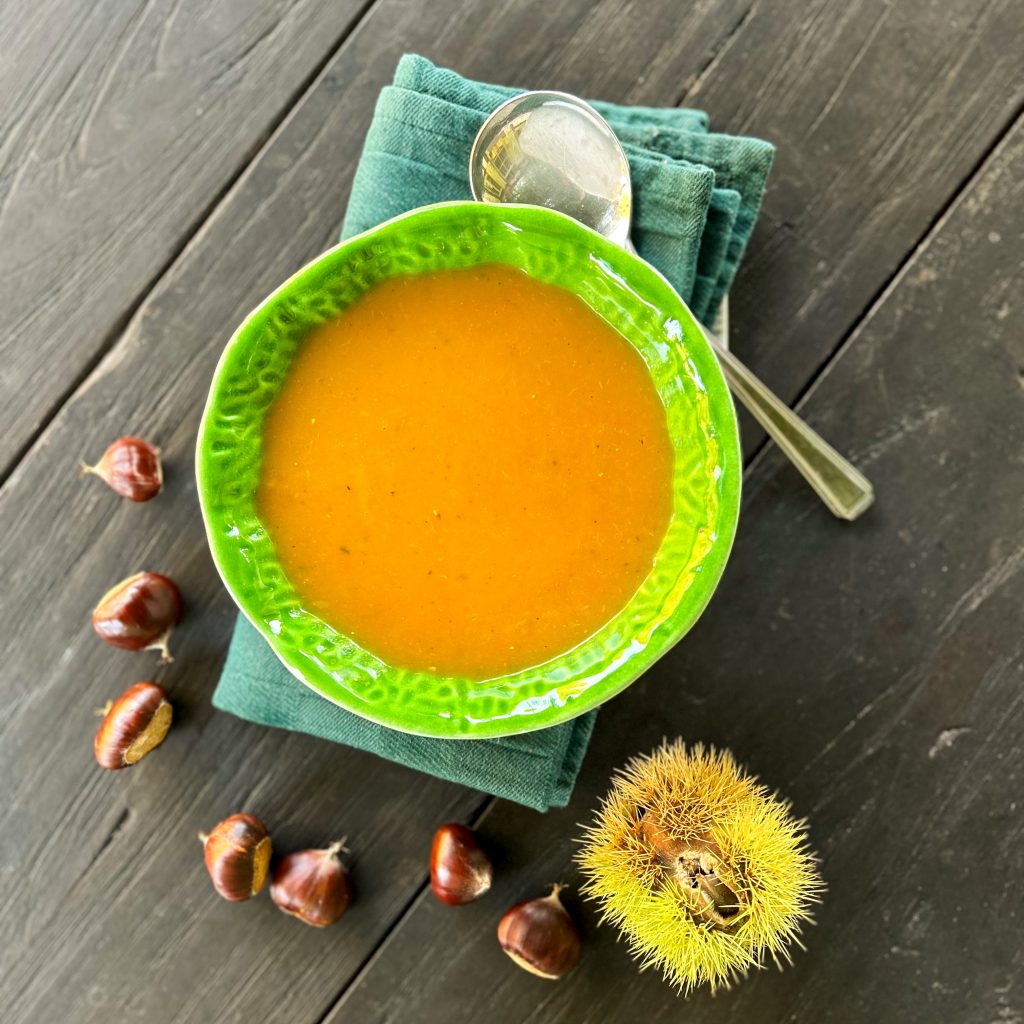
Butternut squash and chestnut soup There are some newcomers at our homestead, some welcome, others not so much. In August we inadvertently became hosts to five million bees. We didn’t actually count them because that would have been laborious and dangerous, we counted the hives and used a calculator. The average beehive houses between 20,000 and 80,000 bees, and there are just over 100 hives. The problem is not the hives, but the fact that the bees use our pool; seemingly for recreation as well as quenching their thirst! After a bit of research, we discovered that a beekeeper, based over 60kms away, wanted to make heather honey, and decided our land was the ideal place to do it. Apparently it didn’t occur to him to ask our permission, for the use of the heather or the pool. I’m all for bees; in fact I’m a big fan, I’m just not keen on swimming with them. We suggested they pay their rent in honey: it will be honetary compensation!
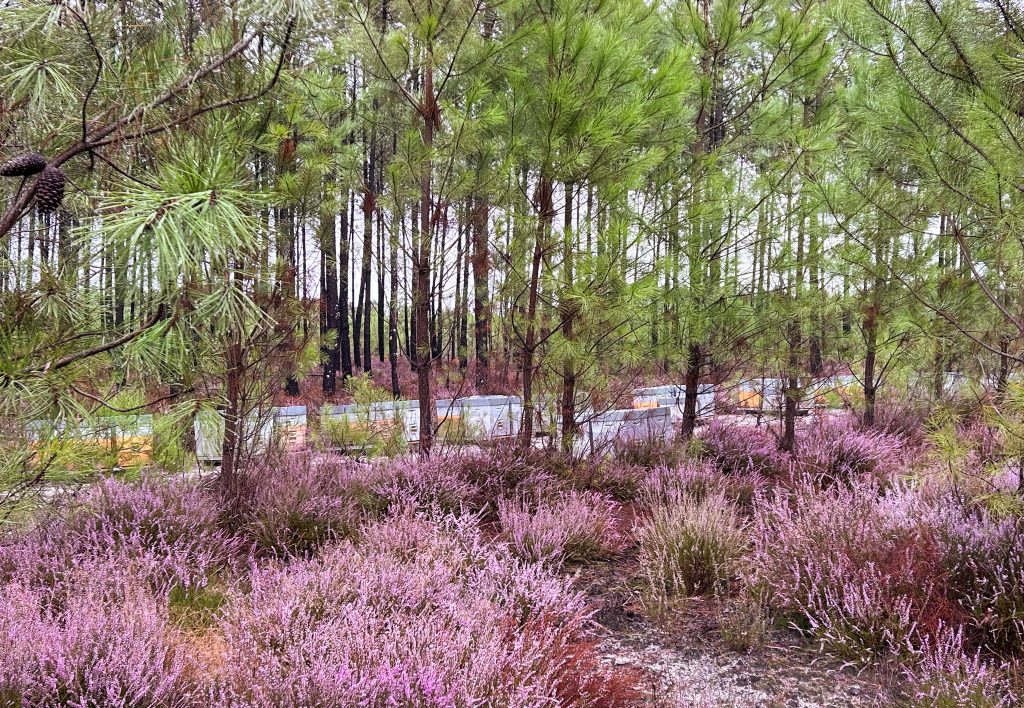
Over a hundred bee hives in the heather Equine segregation
We also have two more horses. One of the horses, Bijou, we owned already, but he has been on loan to a nearby riding club, having been chased from his stable by our two grays. Whoever imagines that horses are not racist, imagines wrongly. The grays used to make life very difficult for Bijou who is chestnut, by blocking his access to hay, chasing him around the field and generally behaving like grey-supremacist hooligans. Now Bijou has his own fields and a gorgeous, newly-acquired chestnut friend called Jazz. Their contact with the greys is restricted to unpleasantries over the fencing.
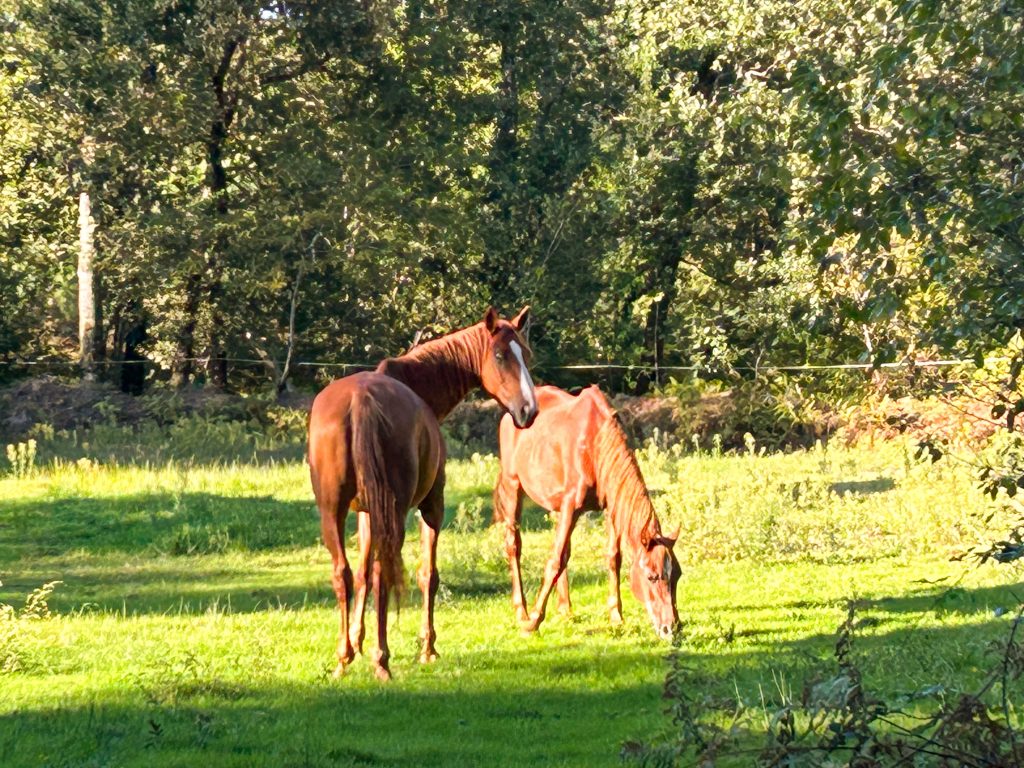
Bijou and Jazz, the chestnuts 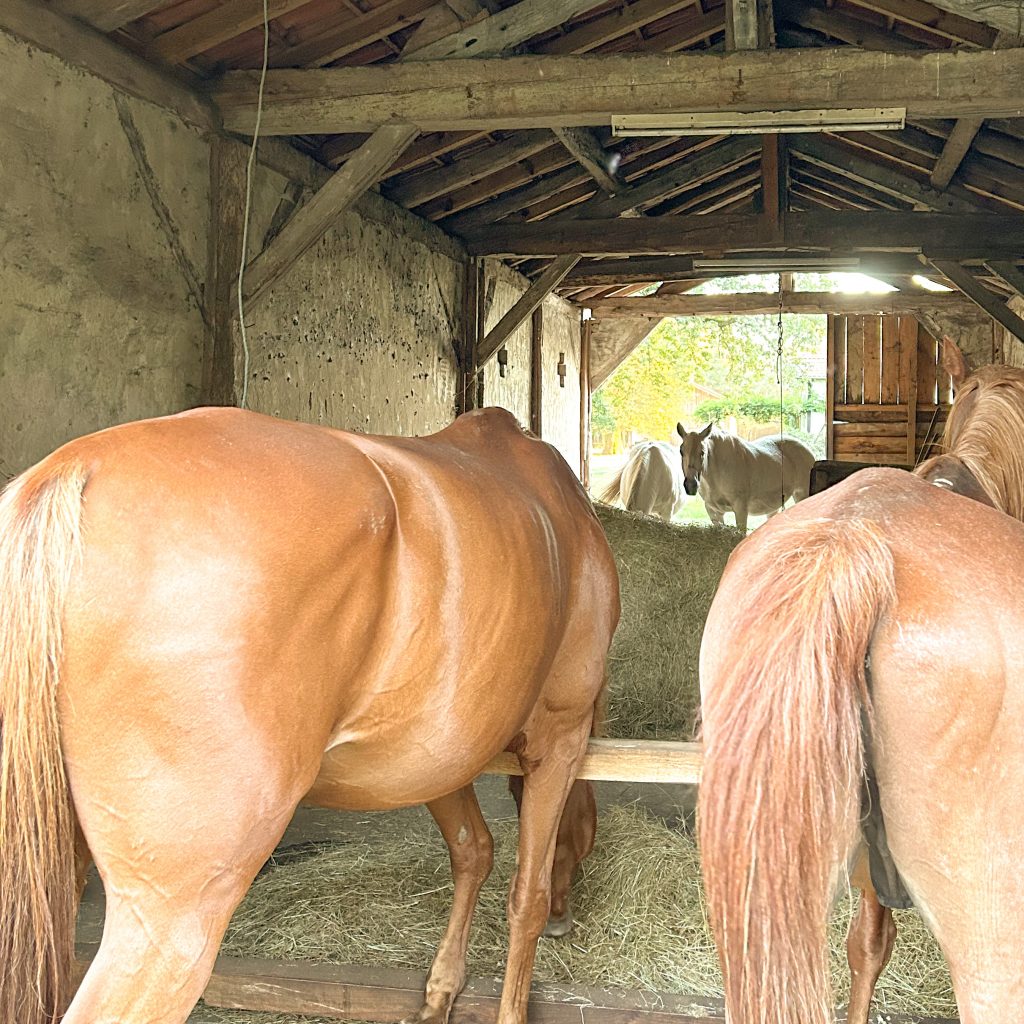
Equine segregation 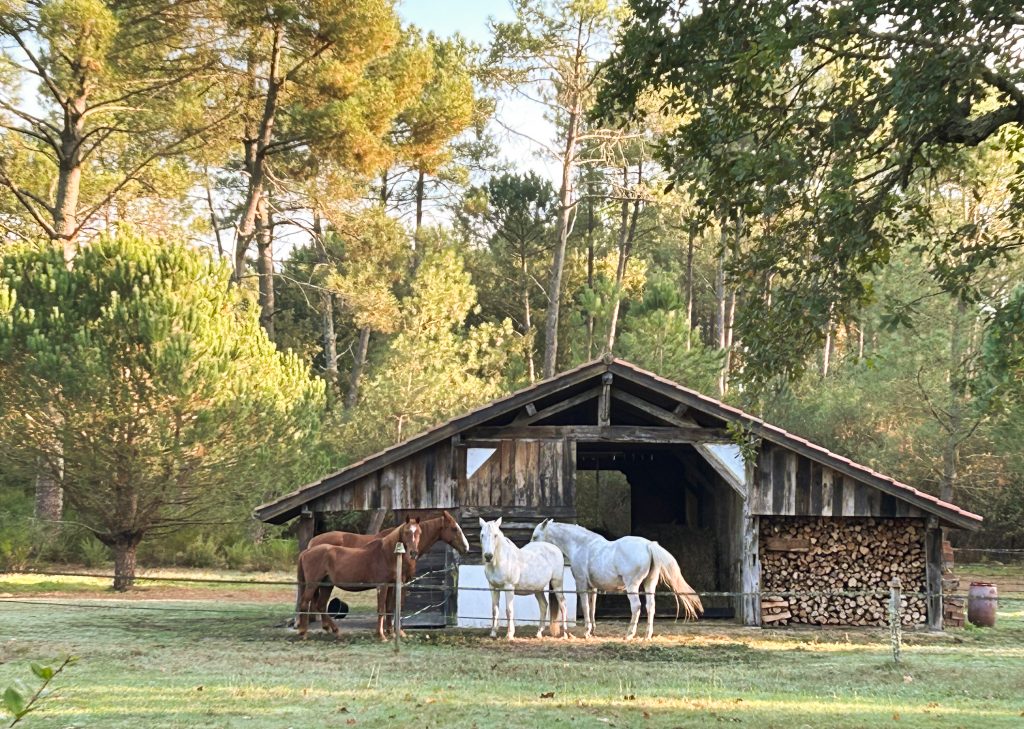
Heated discussions Chestnuts (the nuts, not the horses) are nutrient-dense. They are vitamin and mineral-rich, and also a great source of antioxidants. Chestnuts are high in fibre, which means they are effective for both blood sugar and hunger control. The tannins and flavonoids help suppress inflammation and in-vitro studies show that extracts from chestnuts suppress the growth and spread of various types of cancer cells.
Recipe for butternut squash and chestnut soup (serves 6)
- 1 tablespoon olive oil
- 1 tablespoon butter
- 1 onion, chopped
- 250g of pre-cooked chestnuts
- 1 butternut squash, peeled and cut into cubes
- 2 carrots, peeled and cut into rounds
- 1.5 litres of chicken stock
- Sea salt and freshly ground black pepper
- Curry powder to taste (optional)
- 200ml cream
Fry the onions in the olive oil and melted butter until golden brown. Add the chestnuts, butternut squash and carrots and then chicken stock and bring to the boil. Season and cook for about 30 minutes, or until the vegetables are soft. Add the cream and purée until smooth.
-
Honey mustard chicken and lots of beefing

I don’t know whether it’s a January thing, but I’m surrounded by whingers. First there’s Léo who says I should take a leaf from his grandmother’s book and buy him clothes that are big enough. According to his theory, I refuse to buy him bigger clothes because I don’t want him to grow up. He might have a point – there’s something very disconcerting about rollicking a 6ft tall 13-year-old. But to be honest I think it’s more to do with the fact that clothes shopping turns me into a perspiring, hyperventilating, irascible wreck. Even more so than usual. You know those parents that complain that their teenagers don’t talk to them? Well that’s not me; mine talks to me in spades and the words are incisive and abundant. I’m preparing myself for further stories of woe about freezing-cold ankles and wrists.
And then there’s Hugo who is displeased with his new food. As you might imagine, he’s not subtle in his revulsion and sneers at his bowl before leading us to the cupboard in search of something more palatable. He is also very put out by the fact that we prefer he lie on his bed than the sofas and, to top it all off, is quite underwhelmed by our new choice of camembert.
On the other hand there’s little Java. I bought her a new collar and, if her look was anything to go by, I don’t think the colour can have been her absolute favourite. But did she go on and on about it? No, she graciously refrained from chewing it to bits and quickly moved on to other things. Oh the joys of the innate Attention Deficit Disorder of young English setters!
This dish is very easy and very delicious, perhaps even more so as I used my husband’s rather expensive, fragrant honey. Anyway, we won’t dwell on that or I’ll be in for another ticking-off. Mind you, it’ll be water off a duck’s back because I’m about to invest in some heavy-duty earplugs.Ingredients (serves 4)
3 tablespoons Dijon mustard
3 tablespoons honey
1 tablespoon olive oil
1 clove of garlic, crushed
1 teaspoon paprika
Sea salt and freshly ground black pepper
8 chicken thighs, skins removedPreheat the oven to 180°C. In a small saucepan over a gentle heat, whisk together the mustard, honey and olive oil. Add the garlic and seasoning, mixing well.
Arrange the chicken thighs in an oven-proof dish and pour the sauce over the top, making sure that the thighs are well covered. Bake for abour 45 minutes or until the sauce begins to caramelise. I serve this with mushroom risotto and a green salad. -
Thank you honey !

 2014 is the year of the bee as far as I’m concerned (thank you to Léo for the drawing). I’ve just finished reading a book that has convinced me that the value of honey goes far beyond those mentioned in my previous honey post. The book is called The Honey Diet and is written by a Scottish chemist, Mike McInnes. It is touted as a diet book, which I think rather belittling. This is really is so much more. Not only does it contain fascinating information, it is also groundbreaking, agenda-free science combined with good common sense.
2014 is the year of the bee as far as I’m concerned (thank you to Léo for the drawing). I’ve just finished reading a book that has convinced me that the value of honey goes far beyond those mentioned in my previous honey post. The book is called The Honey Diet and is written by a Scottish chemist, Mike McInnes. It is touted as a diet book, which I think rather belittling. This is really is so much more. Not only does it contain fascinating information, it is also groundbreaking, agenda-free science combined with good common sense.
Mike McInnes describes in detail the benefits of eating raw honey and clearly explains the way the body metabolises it, which is very different from the way other sugars are metabolised. Honey has a perfect fructose/glucose balance, easily assimilated by the liver where it is then used as a necessary and convenient source of fuel. This easy assimilation also means that honey does not cause damaging insulin spikes.
To put it another way, when you eat a spoonful of honey your body says: ‘Excellent! This is high-quality fuel that I can put to good use so I’ll start using it straight away.’ When you consume a spoonful of sugar or other refined sweeteners it says: ‘What on earth is this and what am I supposed to do with it? I have absolutely no idea so I’ll stock it away as fat until I’ve figured something out’.
Taking a spoonful of honey before bed ensures deeper and more restorative sleep as it effectively feeds the liver overnight, allowing it to carry out the numerous tasks it undertakes while the body is asleep. Like most things, the body can’t operate without effective fuel, which means that having to deal with an unwelcome diet of artificial foods prevents it from being able to carry out even the most basic maintenance work. Properly fuelled up, the body will burn more calories overnight than would be burned during a 10km run and it will do this without having to send ‘help! I need more fuel’ distress signals, which invariably prevent you from sleeping properly.
If you look into the intelligent and efficient way that bees operate, it’s hardly surprising that they create such perfect nourishment. They are the earth’s hardest working creatures and models of efficiency and cooperation.



They have developed a complex communication system to impart information to other bees regarding sources of nectar. They do a little dance to indicate the direction in which the food source may be found in relation to the position of the sun. The amount of waggling involved in their dance indicates the distance of the food from the hive and then a wing-fanning display gives information as to the richness of the source.
Bees give a whole new meaning to multi-tasking! -
Raw honey and learning when to stop talking

We went to a local Christmas market this weekend and, while I was busy buying my own bodyweight in locally-produced Landaise honey, Léo was busy consuming his bodyweight in garbure (a duck and vegetable soup typical of Southwestern France). The quantities of food that Léo consumes and the enthusiasm with which he does so, are becoming acute sources of embarrassment to me — you would honestly think that he wasn’t fed at home. Sometimes, for example, we drop into a local café at about 11am for a cup of coffee and he orders a three-course ‘menu du jour’. I desperately feel the need to justify his appetite and end up woefully tying myself in knots with comments like: ‘I do feed him at home you know! In fact I feed him extremely well!’. On realising that this sounds horribly pretentious, I might add: ‘When I say extremely well, obviously I mean, you know, normally. Well not out-of-a-packet normally, but, errr, very healthily’. Of course I end up sounding like a furiously back-pedalling crazy person who should probably learn when to shut up.
Anyway, back to honey. Honey has been used for its healing properties since biblical times when it was used, amongst other things, to treat diphtheria. Physicians of ancient times, such as Aristotle, Hippocrates and Cornelius made reference to its healing qualities. A recent Russian study showed that beekeepers in Georgia who consumed raw honey and pollen on a regular basis frequently lived to over 100, a few even living as old as 150.
Raw honey is honey that has not been heated, pasteurised or processed in any way. It is alkaline-forming and contains a multitude of vitamins, minerals, amino acids, enzymes and powerful antioxidants as well as other natural nutrients. It also contains the enzyme amylase, which aids in the digestion of starch. A piece of toast spread with honey, for example, is more easily digestible than a piece of toast without as the enzymes in the honey ‘predigest’ the starch. (Beware of pasturised honey, which is more or less equivalent to refined sugar.)
Raw honey has anti-viral, anti-bacterial and anti-fungal properties. It promotes general health as well as digestive health and also strengthens the immune system. It helps to control allergies and is an excellent remedy for skin wounds and all types of infections. It can also stabilise blood pressure, balance sugar levels, relieve pain, calm nerves and has been used to treat ulcers. It is an expectorant and has anti-inflammatory properties which means that it is useful in the treatment of respiratory conditions such as bronchitis and asthma.
The different varieties of honey have varying properties as well as quite distinctive aromas. Here are a few:
Acacia, a light and clear honey, is one of the most popular and sweetest honey varieties because of its mild delicate floral taste. Due to its low sucrose content, it is a good choice for diabetics. Acacia cleanses the liver, regulates the intestine, and has an anti-inflammatory action on the respiratory system.
Buckwheat honey is a dark, full-bodied and rich in iron. It contains a higher percentage of antioxidants than other honeys and is perhaps the strongest and darkest of all varieties.
Heather honey is thick, amber in color and has one of the strongest and most pungent flavours. It is fragrant and floral with a very lingering aftertaste that is almost bitter. Prized since ancient times due to its medicinal properties, heather honey is extremely high in protein.
Linden honey is pale yellow in colour with a distinctive yet delicate fresh woody scent. Due to its sedative quality, it is effective in the treatment of insomnia and anxiety. It may also be used to treat colds, coughs and bronchitis.
Pine Tree honey is not overly sweet, has a strong aroma and is rich in minerals and proteins.
Thyme honey’s healing benefits are second to none. It is currently being used in hospitals in France for its infection-fighting, powerful antioxidant properties. A 2009 Greek study found thyme honey to reduce the viability of both endometrial and prostrate cancer cells..
Wildflower honey can vary in colour from very light to dark its flavour ranges from light and fruity to tangy and rich, depending on the mix from the different seasonal wildflowers.
Raw honey should not be given to children under a year old as they lack the stomach acid to de-activate any bacteria. -
Home remedy for tickly coughs

The aim of this ‘recipe’ is not to titillate your tastebuds, but to afford you a nights sleep (or a less irritating day :-)) if you’re suffering from a dry, tickly cough. I discovered this mixture after having tried what seemed like every over-the-counter remedy on sale, as well as numerous prescription medicines. The taste is a bit unusual, so you might have to use a bit of coercion with children. In my experience though, it’s well worth it as it really works better than anything else.
As a rule, coughs should not be suppressed as it’s the body’s way of expelling germs, dust and other irritants. However, if you have one of those irritating dry coughs that just go on and on, then this is definitely worth a try.
Ingredients (one dose)
1 teaspoon honey
1 teaspoon apple cider vinegar (organic if possible)
1/2 teaspoon bicarbonate of soda
1/2 teaspoon freshly grated ginger (optional)
1/4 glass of boiling water
Drop of cold water to cool mixture if necessary
Melt the honey by adding to boiling water, then add the other ingredients one by one. Mix well and drink.
Honey should not be given to children under the age of one. If your cough lasts over ten days, you have trouble breathing or blood in the sputum you should consult a doctor. This post is provided for informational purposes only and is not meant to replace a trained healthcare provider.